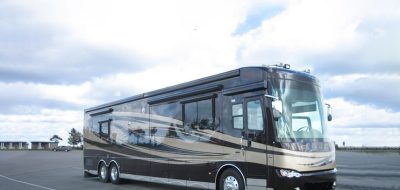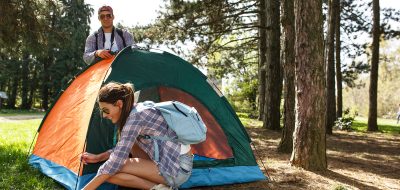When you head out on a trip in your RV you look forward to the sights and scenery along the way, and to the fun you will have when you arrive at your final destination. Nothing will ruin all of the fun and adventure quicker than an unexpected breakdown.
There are three basic types of maintenance for your RV, preventive maintenance, scheduled maintenance and emergency maintenance.
The lack of preventive maintenance and/or scheduled maintenance will eventually result in emergency maintenance. If you don’t check the air pressure in your tires (preventive maintenance) the under-inflated tire over heats and prematurely fails resulting in emergency maintenance.
There are pre-departure safety checks and pre-departure maintenance checks you should make on your RV prior to leaving on a trip. Today we are going to concentrate on some of the maintenance checks you should make before hitting the road.
Check all fluid levels:
a Engine Oil: Automotive wise this is perhaps the most important PM check you can make. Check your engine oil on a regular basis. Add oil as required, but do not overfill. Consult your owner’s manual for the type of oil to use. Have the oil and oil filter changed at manufacturers service intervals.
b. Transmission Fluid: Transmissions in motorhomes and tow vehicles get worked extremely hard. Transmission fluid cools and lubricates the transmission. Checking and maintaining the fluid will extend the life of the transmission. Follow your owner’s manual for directions on how to check the fluid, i.e. hot, cold, in park, in neutral. Add the proper type of fluid as required, but do not overfill. Have the transmission serviced at manufacturer’s service intervals.
c. Power Steering Fluid: Check the power steering fluid. Most power steering reservoirs have a hot & cold level check on the dipstick. Consult your owner’s manual. Add the proper fluid as required.
d. Brake Fluid: Check the brake fluid level in the master cylinder reservoir. If it’s not a see-through reservoir clean the cap off before removing it to prevent dirt from getting in the brake fluid. Consult your owner’s manual for the proper type of brake fluid and add as required, but do not overfill.
Note: The brake system is a closed system and ordinarily does not require additional fluid. If you have to add fluid it may be an indication of a leak somewhere in the brake system. Have it checked out and repaired immediately.
e. Radiator Coolant: Check the radiator coolant reservoir level, condition and concentration. Never remove the radiator cap when hot or under pressure. The coolant reservoir is usually a see-through plastic reservoir with add and full marks on the side. Add coolant as required. Follow the manufacturer’s recommendation for having the radiator flushed and for the proper type and concentration of coolant to use.
f. Windshield Washer Fluid: Check the washer fluid often and keep it full. During winter weather use a washer fluid that will not freeze. Inspect the operation and condition of the wipers and blades. Don’t wait until the wiper blades are worn and brittle. Replace blades at the first indication of poor operation. Cleaning the blades will prolong their life. Use windshield washer fluid on a rag to clean wiper blades.
Check for Leaks: Inspect the engine compartment and underside of the motorhome for any signs of leaks. Leaks of any type can lead to costly repairs and untimely breakdowns. Catching a leak early can save time and money. Identify the source of the leak and have it repaired before using the RV.
Check the Starting and Auxiliary Batteries: Check the battery(s) state of charge, water level, cables and connections. If you’re not familiar with working around lead acid batteries have them checked by a qualified service center.
Check the Condition of your Tires: Look for uneven wear, cuts, poor tread depth and check for dry rot on the tire sidewalls. Check all tires for proper tire inflation with a quality tire inflation pressure gauge. Check the tire pressure before traveling each day and always check the tire pressure when the tires are cold, before traveling more than one mile. Adjust inflation pressure to the manufacturer’s recommendation.
Note: If you discover any problems with your tires have the problem checked out and repaired or replaced before leaving on a trip. Any tire with a 20% or more loss in tire pressure should be checked by an authorized tire center.
Check all Hoses & Belts
a. Radiator & Heater Hoses: Coolant hoses deteriorate from the inside out. Inspect all hoses for wear, cracks, soft spots, brittle areas and leaks. Inspect hose clamps for secure mounting. Replace any damaged hoses or clamps as required. Inspect the face of the radiator for bugs, dirt and debris and clean as required.
b. Brake Hoses: With the vehicle on a level surface, in park, and with the wheels chocked, inspect the hydraulic brake hoses for cracking, scrape marks or wear. If there are any signs of visual damage have the hose replaced immediately. The brakes on a motorhome and tow vehicle get worked hard and often times are abused due to the amount of weight they are required to stop. Follow the manufacturer’s service schedule for your vehicle brakes. Let a professional inspect and repair the brake system. If you hear a high-pitched squeal, or scrapping sound when you apply the brake pedal have the brake system checked and repaired immediately.
c. Belts: Inspect all belts for wear, glazing, fraying, cracks and proper tension. Replace damaged, worn or stretched belts as required. Belts with an automatic tensioner do not require adjustments.
Check all Lights: Make sure all of the lights are clean and working properly. Check the headlights (low & high beam), running lights, turn signals, brake lights and emergency flashers. Check all lights on any vehicle or trailer you are towing behind the motor home. Carry spare bulbs and fuses for the lights. Repair or replace as required.
Gauges and Instrument Panel: Start the engine and warm it up to operating temperature. Verify that all gauges are operating properly. Always monitor your gauges when operating the vehicle. If a gauge shows a reading other than its normal range, or a warning light comes on, pull over as soon as it is safe and have the problem checked out and repaired.
And don’t forget the emergency kit too, just in case there is a breakdown. At a minimum it should include a flashlight, extra batteries, jumper cables, first aid kit, basic hand tools, and warning devices.
Before your next RV trip make your pre-departure maintenance checks and have a great time exploring this wonderful country we live in.
Happy Camping,
Mark Polk







woof
All good stuff. Maybe there could be two catagories of articles; one for the beginner and one for the more advanced.